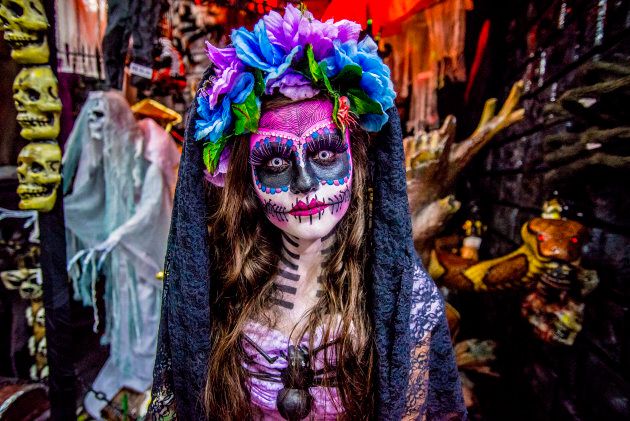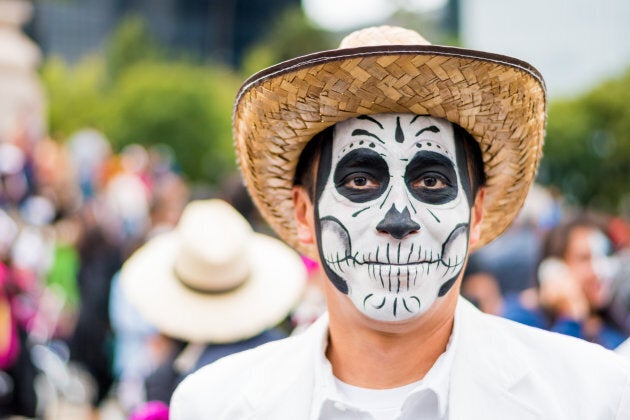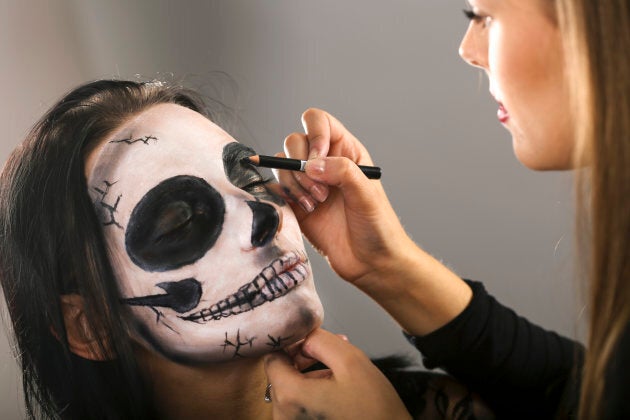There's not much that is very spooky about Mexico's Day of the Dead celebration — unless you count its true significance getting lost amid the makeup mayhem.
A beauty fiend myself, I am in sheer awe of the skeletal masterpieces many makeup artists create for Day of the Dead. But I also shudder when I see La Catrina makeup worn without respect to its cultural significance. So as you scroll your Insta feed searching for the perfect sugar skull skeleton makeup that will make you look ghoulishly gorg, it may be worth finding out what that look is actually about before deciding to don it.

Let's take it back. About 3,000 years.
Day of the Dead is not about being scared of the supernatural, but rather celebrating the spirits of loved ones. Celebrated for nearly 3,000 years, Día De Los Muertos, or Day of the Dead, is one of Latin America's most misunderstood holidays. It may be celebrated right after Halloween on Nov. 1 and 2, and on the surface may even appear to mirror some aspects of it. But it is not "Mexican Halloween."
One might imagine a tradition honouring those lost to be a grim affair, but Día De Los Muertos is far from a somber occasion —it's actually a lively celebration of remembrance and a brief invitation for those souls to visit. On the first day, babies and children that have been lost are celebrated (Día de los Inocentes) and the next day, the adults that have departed are honoured. The belief is that the spirits of the departed are allowed to reunite and communicate with the people they left behind on those two days. During the rituals, families build beautifully decorated altars for their loved ones with offerings of sugar skulls (calaveras), marigolds, toys, food and drinks.
Originally part of Aztec culture, it later became intertwined with Christian culture when the Spaniards conquered Mexico, coinciding with All Saints' Day and All Souls' Day. While initially only celebrated in Mexico, it has since spread to other countries, including parts of India (Goa), the Philippines, the U.S. and even here in Canada, with Day of the Dead events at the Canadian Museum of History and Harbourfront Center.

Don't make a mockery of she who mocks death
One of the most widely recognized symbols of the holiday is La Catrina, or "the lady in the hat." Unlike the skeletons synonymous with Halloween, this female skeleton is dressed to impress. Usually primped in a brightly coloured dress and floral decorated hat, she isn't supposed to be scary, but instead show that it's alright to laugh at death itself. Her elegance is also a reference to the wealthy — signifying a statement that in death, we are all equal. According to Latin Times: "She is offered as a satirical portrait of those Mexican natives who, [the artist] felt, were aspiring to adopt European aristocratic traditions in the pre-revolutionary era."

Can I wear sugar skull makeup?
Catrina — or sugar-skull makeup, as many North Americans refer to it — has gained tremendous popularity over the past several years, thanks in large part to social media and the rise of the "beauty influencer." Makeup artists and beauty bloggers galore share beautiful Catrina looks during the weeks leading up to Halloween and Day of the Dead. And while some are painfully ignorant to the symbolic nature of their designs, many Mexican-American artists choose to celebrate and honour their loved ones during Day of the Dead festivities with what they do best — beauty.
Andrea Ortega Costigan and Mariana McGrath, two Mexican-American makeup artists living in San Francisco and the founders of Salt Spell Beauty celebrate with #sevendaysofsugar every year, showcasing a week of intricate calavera makeup looks. And they are happy to see others mark the holiday as well. They say, "Even if you're not Mexican, we say go ahead and do that sugar-skull makeup for your costume party... all we ask is that you understand the meaning behind it, you take a little slice of the Mexican way, and you remember the people in your life who have passed on to the next."
Think 'Catrina,' not 'clown'
Remember, this isn't Halloween, so give PartyCity a pass. If you're going to do this look, do it right. Many makeup artists prefer to use water-based makeup. A benefit of this is that after it sets you can still apply your usual makeup over top, which you can't do with greasepaint. So you can go bold with blush, eyeliner and OTT goodies like gemstones, glitter and sequins to finish your look.
Find your 'skullspiration'
Mexican-American face-painter Judith Bautista, better known as Kahlovera, is asked to create the look often for Halloween. While she doesn't get offended when asked to do traditional Catrina makeup for Halloween, she does use it as an opportunity to educate people on her culture. "I don't mind people getting dressed up Dia de los Muertos style for Halloween, but if you're going to do it, it would be good to know what you're dressing up as."
Annalisa Rios, a Phoenix Friedas artist and face painter, echoes the other makeup artists. "I think the most important things to know is that (people usually associate it with) Halloween, but it's not," she says. For those that would like to try the makeup she offers this advice: "There's no right or wrong way... as long as it's a representation of yourself or a loved one."
While the makeup is undoubtedly beautiful and often painstakingly intricate in its design, there is also meaning behind some of the vibrant colours adorned during the festivities, according to Rios.
Yellow – Sun and unity, because under the sun, we're all the same.
White – Spirit, hope and purity.
Red – Blood and life.
Purple – Mourning, grief and suffering.
Pink – Happiness.
These days, the world is at your fingertips. There are are countless online videos and step-by-step tutorials to create a beautiful Catrina makeup look. But the real skullspiration hopefully comes from the loved ones you are honouring in creating it.
Meera Estrada is a Fashion & Culture Expert. Follow her on Instagram @meera_fusia and Twitter @MeeraEstrada.
Follow HuffPost Canada Blogs on Facebook
Also on HuffPost: